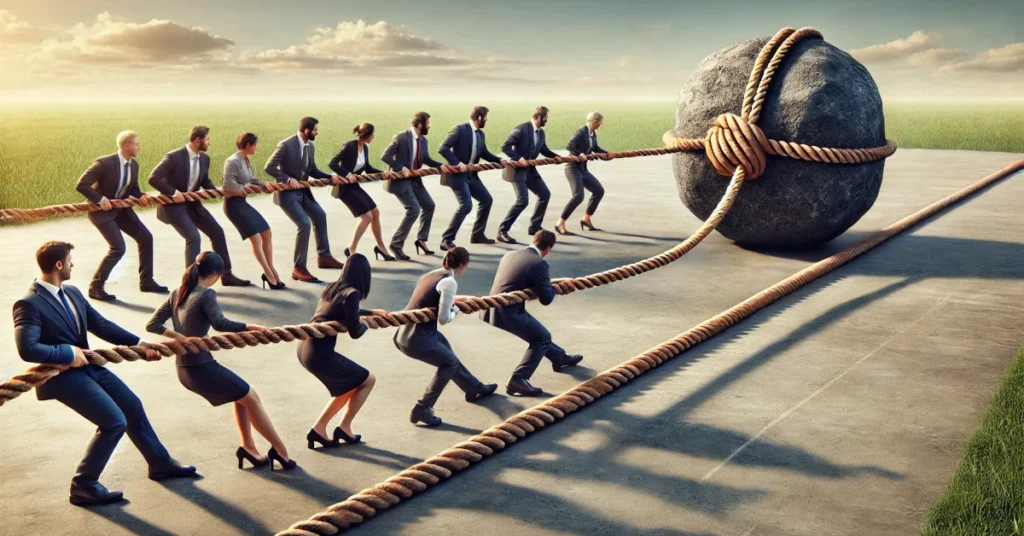
Estimated reading time: 6 minutes
The Cost of Goal Misalignment
How Long-Term and Short-Term Goal Misalignment Stagnate Growth
Estimated costs of goal misalignment can be as high as 25% of revenue, according to the Predictive Index. Strategy&, a PWC publication, confirms it’s a broad problem with these results:
- 74% of executives acknowledge that their strategies fail to translate effectively into actionable steps.
- 79% of executives worry their organization lacks the resources necessary to execute their strategic plans.
- 67% of critical organizational functions are misaligned with corporate strategy, resulting in wasted effort.
Addressing goal misalignment between long-term strategy and short-term objectives is paramount for success. Yet, many organizations falter in achieving this balance, leading to wasted resources, missed opportunities, and fragmented efforts. These challenges are operational and deeply human, affecting teams’ morale and an organization’s capacity for sustainable growth.
To address these issues, I bring a people-first management approach rooted in servant leadership and focused on performance transparency. My method emphasizes creating transparent performance metrics that foster psychological safety and drive results through collaborative and human-centered management practices.
Contact me to explore how misalignment impacts businesses and how my leadership style can help resolve these inefficiencies.
The High Stakes of Strategic Misalignment

Wasted Resources
When short-term initiatives fail to align with long-term strategies, resources are squandered. Organizations often prioritize immediate gains over strategic investments, diverting funds and energy to projects that offer no lasting value. For example, consider companies that chase fleeting market trends or introduce products misaligned with their core mission. The result? Wasted budgets, overworked teams, and missed chances for meaningful growth.
Missed Opportunities
A short-term focus often blinds organizations to long-term opportunities. Companies that fail to anticipate market shifts, adopt innovations, or pivot to emerging trends risk becoming obsolete. Misalignment discourages proactive investment in future-ready initiatives, leaving the organization vulnerable to competitors who better integrate short- and long-term thinking.
Fragmented Efforts
Departments working in silos exacerbate misalignment. Teams may pursue divergent priorities, creating inefficiencies that ripple throughout the organization. A lack of cohesion between departments leads to duplicated efforts, conflicting objectives, and an inability to capitalize on shared resources.
Real-World Examples of Misalignment
23andMe’s Strategic Shift
23andMe, a pioneer in genetic testing, provides a cautionary tale about goal misalignment and its cascading effects. A recent Wall Street Journal story tells how the company’s recent decision to cut 40% of its workforce and shut down its drug development division highlights how misaligned priorities can derail progress. While the move reduced costs in the short term, it directly contradicted the company’s long-term strategy of expanding into personalized medicine, a cornerstone of its growth vision. This goal misalignment resulted in a staggering $59 million net loss last quarter and eroded workforce morale, showcasing how the lack of alignment between short-term actions and long-term objectives can lead to stagnation and setbacks. (Source: WSJ)
Burberry’s Reinvention
Luxury brand Burberry faced stagnation after years of inconsistent execution. To realign with its long-term goals, the company cut costs, focused on core products like outerwear, and adopted new pricing strategies, as reported in the Wall Street Journal. While these changes yield short-term stabilization, Burberry’s actual test will be whether these efforts align with its broader vision of sustainable growth in a challenging luxury market. (Source: WSJ)
Driving Alignment Through Transparent and People-First Leadership
Achieving alignment requires a balanced approach that connects the dots between strategy and execution. This is where my servant leadership style excels. By intertwining elements of psychologically safe management, transparent performance practices, and results-driven operations, I help organizations achieve sustainable, people-centered growth. Let’s break down how this approach addresses misalignment:
Psychologically Safe Management
Psychological safety fosters an environment where employees feel empowered to voice ideas, raise concerns, and innovate without fear of retribution. Research from Harvard Business Review shows that psychologically safe teams are more adaptive, collaborative, and effective at solving complex problems. Leaders who prioritize safety build trust and engagement, ensuring every short-term initiative contributes to the company’s larger vision.
Transparent Performance Management
Clarity in performance metrics ensures alignment at all levels. Employees need to understand how their individual goals feed into team objectives and, ultimately, organizational strategy. Transparent systems highlight the direct impact of short-term efforts on long-term success, fostering accountability and a shared sense of purpose.
Results-Driven Practices
Strategic alignment isn’t about rigid adherence to plans—it’s about achieving measurable outcomes. Results-driven management empowers teams to adapt short-term actions to meet changing conditions while staying anchored to long-term objectives. This balance is essential for navigating today’s volatile markets.
Strategies to Realign Goals

Here are three actionable strategies I recommend to ensure alignment between short- and long-term goals:
- Clarify Vision at Every Level
Leaders must clearly articulate the organization’s long-term vision and continuously tie it to short-term actions. This communication is not a one-time effort; it requires ongoing reinforcement and feedback loops to keep teams focused and engaged. - Implement Integrated Planning Processes
Develop planning processes that link short-term milestones with long-term outcomes. Tools like OKRs (Objectives and Key Results) can create a structured framework, ensuring that every short-term goal advances the broader strategy. - Empower Through Transparency
Use performance dashboards, town halls, and open communication channels to keep teams informed of progress toward both short-term and long-term objectives. Transparency fosters accountability and builds trust, ensuring alignment at every organizational level.
The Role of Leadership in Avoiding Stagnation
Leadership is the linchpin for driving alignment. A servant leadership approach puts people at the center, empowering them to contribute meaningfully while ensuring their efforts align with organizational priorities. This leadership style is inherently collaborative, prioritizing team well-being alongside performance.
When leaders combine servant leadership with transparent, results-focused practices, they create an organizational culture that thrives on alignment. Teams work cohesively, resources are allocated efficiently, and long-term goals become actionable realities.
Your Next Steps
Misalignment between long-term strategy and short-term goals is not just an operational hurdle—it’s a significant threat to growth and sustainability. The good news? It’s a challenge you don’t have to face alone.
With decades of experience in operations leadership, I specialize in helping organizations like yours realign their strategic priorities. My proven approach leverages:
- Psychologically safe management to build resilient teams.
- Transparent performance systems to ensure alignment.
- Results-driven operations to achieve sustainable growth.
Let’s connect if your company struggles with stagnant growth, misalignment, or other inefficiencies. We can create a cohesive strategy that maximizes your resources, captures new opportunities, and positions your organization for long-term success.
Don’t wait for misalignment to erode your company’s potential. Book a Call today to unlock your operations’ full potential.